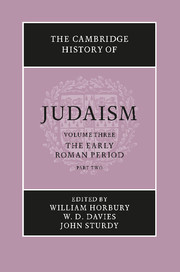Book contents
- Frontmatter
- 1 The archaeology of Palestine 63 bce–ce 70
- 2 The Herodian Temple
- 3 Recent archaeology in Palestine: achievements and future goals
- 4 The contribution of Jewish inscriptions to the study of Judaism
- 5 The social, economic and political history of Palestine 63 bce–ce 70
- 6 The Diaspora in the Roman period before ce 70
- 7 The Gentiles in Judaism 125 bce–ce 66
- 8 Gentiles as seen by Jews after ce 70
- 9 The synagogue
- 10 The Temple and the synagogue
- 11 The early liturgy of the synagogue
- 12 Women in the synagogue
- 13 The Pharisees
- 14 The Sadducees – their history and doctrines
- 15 The Essenes
- 16 The baptist sects
- 17 The troublemakers
- 18 The Samaritans and their sects
- 19 Galilean Judaism and Judaean Judaism
- 20 Jesus: from the Jewish point of view
- 21 Paul: from the Jewish point of view
- 22 Jewish Christianity
- 23 Apocalyptic: the disclosure of heavenly knowledge
- 24 The Qumran sectarian writings
- 25 The Dead Sea Scrolls and pre-Tannaitic Judaism
- 26 Prayer in the Qumran Texts
- 27 Philo of Alexandria
- 28 Josephus (ce 37–c. 100)
- 29 The rabbi in second-century Jewish society
- 30 The Hellenistic–Roman Diaspora ce 70–ce 235: the archaeological evidence
- 31 The legacy of Egypt in Judaism
- 32 Jewish elements in gnosticism and magic c.ce 70–c.ce 270
- Bibliographies
- Index
- References
24 - The Qumran sectarian writings
Published online by Cambridge University Press: 28 March 2008
- Frontmatter
- 1 The archaeology of Palestine 63 bce–ce 70
- 2 The Herodian Temple
- 3 Recent archaeology in Palestine: achievements and future goals
- 4 The contribution of Jewish inscriptions to the study of Judaism
- 5 The social, economic and political history of Palestine 63 bce–ce 70
- 6 The Diaspora in the Roman period before ce 70
- 7 The Gentiles in Judaism 125 bce–ce 66
- 8 Gentiles as seen by Jews after ce 70
- 9 The synagogue
- 10 The Temple and the synagogue
- 11 The early liturgy of the synagogue
- 12 Women in the synagogue
- 13 The Pharisees
- 14 The Sadducees – their history and doctrines
- 15 The Essenes
- 16 The baptist sects
- 17 The troublemakers
- 18 The Samaritans and their sects
- 19 Galilean Judaism and Judaean Judaism
- 20 Jesus: from the Jewish point of view
- 21 Paul: from the Jewish point of view
- 22 Jewish Christianity
- 23 Apocalyptic: the disclosure of heavenly knowledge
- 24 The Qumran sectarian writings
- 25 The Dead Sea Scrolls and pre-Tannaitic Judaism
- 26 Prayer in the Qumran Texts
- 27 Philo of Alexandria
- 28 Josephus (ce 37–c. 100)
- 29 The rabbi in second-century Jewish society
- 30 The Hellenistic–Roman Diaspora ce 70–ce 235: the archaeological evidence
- 31 The legacy of Egypt in Judaism
- 32 Jewish elements in gnosticism and magic c.ce 70–c.ce 270
- Bibliographies
- Index
- References
Summary
THE DEAD SEA SCROLLS
The Dead Sea Scrolls (DSS) from Qumran comprise a corpus of nearly 800 ancient Jewish documents written in Hebrew, Aramaic and Greek. The texts were recovered in varying states of repair between 1947 and 1956 from eleven caves around the site of Khirbet Qumran on the northwestern edge of the Dead Sea. On the basis of the general results of palaeography, carbon dating and archaeology, it became clear that the writings stemmed from the last three centuries of the Second Temple period. Although much important material was published in the first two decades after the discovery, it was not until 1991 that numerous outstanding texts from Cave 4 were released. This event led to a revival of interest in the DSS, as well as the official publication of works previously available only to a small coterie of scholars.
To aid discussion, it is possible to divide up the DSS collection in several ways. One fruitful approach is to split the manuscripts into three categories: (a) books in use among all Second Temple Jews and later forming the Hebrew Bible defined by the rabbis after ce 70, (b) other works, including several Apocrypha and Pseudepigrapha, also circulating beyond the confines of the Qumran group, and (c) the so-called sectarian DSS apparently composed by the religious community behind the corpus. It is worth defining each class a little more carefully.
The first comprises biblical books which are written in Hebrew – either in the palaeo-Hebrew characters of the pre-exilic period or, more normally, the square script that predominated from post-exilic times.
- Type
- Chapter
- Information
- The Cambridge History of Judaism , pp. 798 - 821Publisher: Cambridge University PressPrint publication year: 1999

